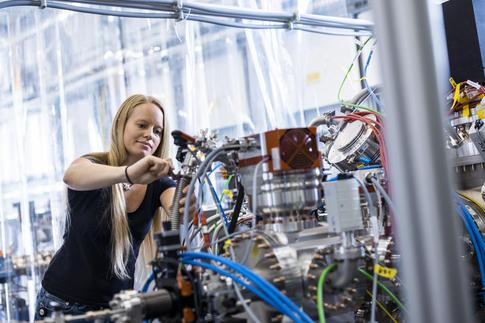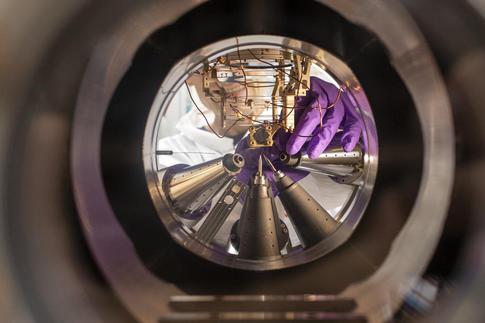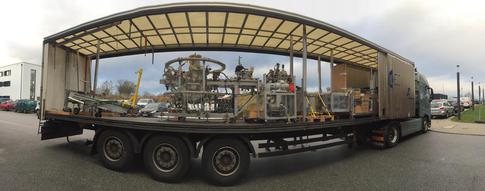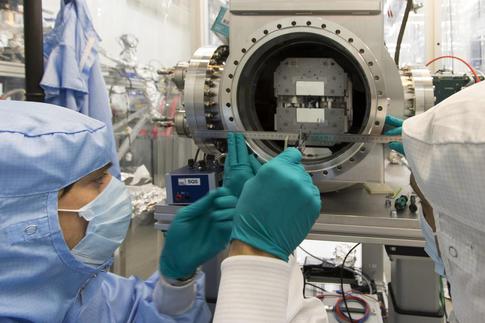XFEL: All SQS experiment stations up and running
All SQS experiment stations up and running

SQS scientist Rebecca Boll makes final adjustments on the AQS experiment station before the first users arrive at the end of 2018. Copyright European XFEL
The soft X-ray instrument for Small Quantum Systems (SQS) welcomed its first users at the end of 2018. Now, almost a year later, the SQS team and collaborators have completed their ambitious plan to install and commission all three experiment stations, each specifically designed for different types of experiments and samples, ranging from atoms and small molecules to large clusters, nanoparticles and biomolecules. We look at how the instrument has developed during the past year, how important collaboration has been for the success of SQS so far, and what lies ahead.
Getting started with AQS
The first experiments at Small Quantum Systems (SQS) back in November 2018 were planned as a continuation of the relatively short commissioning phase and to demonstrate what the instrument is capable of. The hard work paid off, and the first experiments were a success. Using the Atomic-like Quantum Systems (AQS) station, the first of the three stations to be installed at SQS, the team used ion spectroscopy to measure multiply charged ions of noble gases such as xenon and neon, and recorded the electron spectra of these gases. “With a single X-ray pulse we can strip many electrons off an atom, creating highly charged ions, like Xe41+, for example,” explains Michael Meyer, lead scientist at SQS. “Thanks to the high repetition rate of the European XFEL we are now able to not only detect the ions that are produced, but also analyze the outgoing electrons at high resolution. This was extremely difficult to do before. Now we can see when and how electrons are ejected from an atom or molecule, and we have even detected electrons which result from the simultaneous interaction with two X-ray photons – a highly unlikely process!”

A view into the AQS experiment station showing five electron time-of-flight spectrometers and the velocity-map-imaging spectrometer. Copyright European XFEL
In particular, by taking advantage of the easy wavelength tunability of the soft X-ray undulator it was possible to access specific resonances which are produced after the absorption of two photons. “This type of spectroscopy is a unique tool requiring the high intensity and short pulse durations of a free-electron laser. The recorded spectra allow us, for example, to perform a very sensitive analysis of the chemical environment of an atom in a molecule”, says Tommaso Mazza, scientist at SQS and principle investigator of the first experiment.
The REMI moves in
A few weeks after those first experiments, the second station - the Reaction Microscope (REMI) - was delivered and installed at SQS. The REMI, designed for ion and electron momentum imaging experiments in the gas phase, is a user contribution from the University of Frankfurt and represents years of collaborative research effort. The team from the University of Frankfurt spent two months at European XFEL working with the SQS team on the installation of the REMI, before finally starting the first experiments together with a large international group of users just two weeks after installation and commissioning was completed.

The REMI experiment station arrives on site. Copyright Rebecca Boll
Principal investigator Till Jahnke from Frankfurt was impressed with the experimental capabilities at European XFEL for soft X-ray science: “We have learnt a lot during the three months installing, commissioning and running our experimental station together with the SQS team. The distinct features of the European XFEL - in particular its high repetition rate - finally let us enter a new frontier of our coincidence studies. Areas of our research field that were previously unattainable now come into reach. I am very curious about the scientific outcomes in the near future and the scientific possibilities that emerge from the European XFEL.”
The REMI enables scientists to study a single molecule interacting with the X-ray pulse and to follow the reaction step-by-step, understanding, for example, how and when the molecule breaks apart. ”With the REMI we can start to answer specific questions such as whether it is an instantaneous explosion, or whether the bonds break one by one” says Meyer. The critical component for such a coincidence experiment is to be able to measure multiple ions and/or electrons that originate from the same molecule. To achieve this, the experimental conditions are tailored so that each of the intense X-ray pulses only interacts with one single molecule. This requires, for example, an extremely good vacuum (10-11 mbar) and a very good alignment of the beamline, so that the photon beam does not hit anything on its way to the interaction point – a challenging task for the initial set-up. “Once this is achieved, we can ensure that all ions and electrons that are detected by the REMI for one X‑ray pulse originate from the very same molecule – the key requirement for coincidence experiments,” explains Rebecca Boll, scientist at SQS. “In this way, we can reconstruct the geometry of the molecule at the moment when it breaks up”. With the REMI at SQS it was demonstrated that this can be achieved even for comparably large molecules. In a next step this technique will be used to record movies of molecular break-up by first triggering a reaction with an external optical laser and then image the structure after a certain delay time with the X-ray pulse in so-called pump-probe experiments.
NQS completes the trio
The third and final experimental station at SQS, the Nano-sized Quantum Systems (NQS) station, was installed in May 2019, completing the trio. The NQS, comprising interchangeable photon detectors, charged particle spectrometers, and sample delivery sources, is dedicated to the investigation of larger systems such as clusters and nano-particles. “Our plan was to get all three – AQS, REMI, and NQS – installed and operational in the first user run. Of course this was very ambitious, but we wanted to demonstrate to our user community that they all work as they were designed to, even if that meant more upheaval initially” smiles Meyer.

Scientists install the pnCCD, a large-area photon detector into the NQS experiment station. Copyright European XFEL
Close collaboration with the user community was an important point already in the design phase of the NQS. Members of the groups of Thomas Möller from the Technical University Berlin and Daniela Rupp from the Max-Born-Institute Berlin developed a sample delivery source for clusters and nano-droplets for the station, and also spent several weeks at European XFEL helping to get it operational. This effort was rewarded by a successful beamtime on superfluid helium nano-droplets in which different atoms or molecules were embedded. “Unique nanostructures are created in the extremely cold droplets and the process of their assembly becomes visible in the diffraction images. We were able to record images of single droplets giving evidence of novel nanostructure arrangements. This may have a strong impact on the research of nano-systems.” said project leader Daniela Rupp.
During the last beamtime of the first user run, the team experienced another highlight: the first user experiment on biomolecules. The users were enthusiastic. “The NQS endstation at SQS is the best we have used for single particle imaging of small samples!” said Filipe Maia from Uppsala University who led the experiment. Small particles scatter only a few photons, making it particularly difficult to record high quality images and to separate clearly the signal from any background disturbance. These drawbacks can partly be compensated by the high scattering probabilities in the soft X-ray wavelength regime. Janos Hajdu also from Uppsala University added: “Dreams may take their time to reach fulfillment, and some of them always just stay dreams. The dream of being able to take images of single particles is finally coming close to reality. It’s wonderful!” The SQS scientists and users hope these developments will help the community achieve the goal of being able to reconstruct high quality 3D models of single biomolecules in the future.
Looking forward
“It’s great to finally see the fruits of our labor and to be able to demonstrate to our users what type of experiments can be done at SQS” says Meyer. But despite the success, the SQS team is not ready to rest just yet. In addition to gaining further experience using the three experimental stations, they are now in the process of commissioning an optical laser to be used in combination with the X-ray pulses. “We’re aiming to do the first pump-probe experiments before the end of the year” says Meyer. “That will open another exciting research field, namely time-resolved experiments, which take advantage of the extremely short duration of the X-ray pulses. This will allow us to watch and follow in real time the dissociation of a molecule and other processes triggered by the absorption of a photon!”
Further reading:
SQS instrument page
SQS group page
For more information about experiment capabilities and possibilities at SQS, please contact the group members directly.
